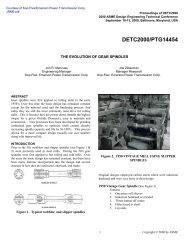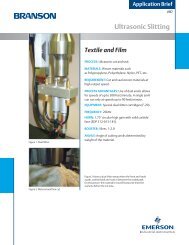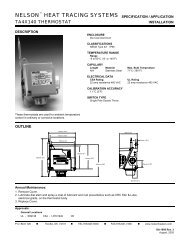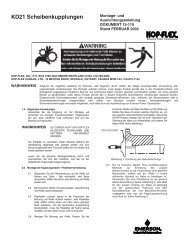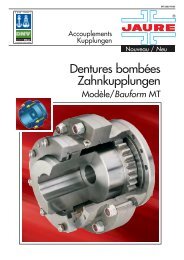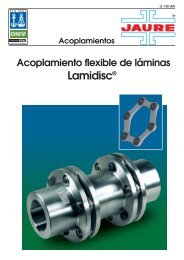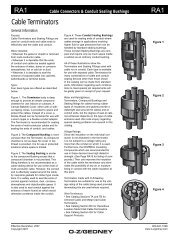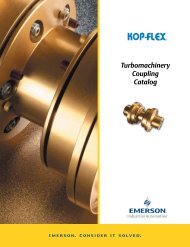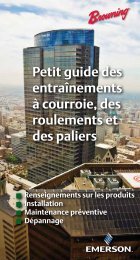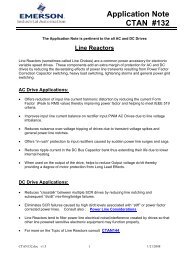Kop-Flex Industrial Coupling Product Catalog - Form 8887E
Kop-Flex Industrial Coupling Product Catalog - Form 8887E
Kop-Flex Industrial Coupling Product Catalog - Form 8887E
You also want an ePaper? Increase the reach of your titles
YUMPU automatically turns print PDFs into web optimized ePapers that Google loves.
Flanged Universal Joints<br />
Selection Procedure<br />
U-Joint Selection Consideration<br />
Bearing Life (B 10<br />
or L h<br />
) calculation<br />
A. For constant speed and operating angle conditions.<br />
[ ]<br />
Lh = 1.5 x 10 6 10<br />
Lf<br />
3<br />
a x N<br />
T A<br />
Lh = Bearing (B10) Life (hours)<br />
a = Operating angle (degree)<br />
N = Maximum operating speed (RPM)<br />
Lf = Life Factor (See chart)<br />
T A<br />
= Application Torque (lb-in)<br />
B. Duty Cycle B 10<br />
calculation. (usually<br />
mill type applications)<br />
In applications where the torque, speed,<br />
and operating angle occur predictably<br />
during a operating load cycle. For<br />
these applications the B-10 life should<br />
be based on this duty cycle.<br />
Lf (Bearing Life Factor)<br />
SIZE/PART<br />
NUMBER<br />
Lf<br />
(lb-in.)<br />
LIGHT SERIES<br />
ULCBK60<br />
2,250<br />
ULCBK90<br />
7,850<br />
ULDCBK98<br />
12,800<br />
ULCBK115<br />
18,000<br />
LE =<br />
1<br />
ULCBK125<br />
27,700<br />
ULCBK155<br />
41,150<br />
[ ( t 1<br />
/ L 1<br />
) + ( t 2<br />
/ L 2<br />
) + ( t 3<br />
/ L 3<br />
) + **etc ]<br />
ULCBK160<br />
53,500<br />
ULCBK170<br />
69,600<br />
ULCBK174<br />
70,000<br />
L E<br />
= Cumulative B 10<br />
life for the Duty ULCBK178<br />
75,000<br />
cycle (hours)<br />
ULCBK204<br />
113,500<br />
L 1<br />
= Life expectancy at operating condition ULCBK215<br />
145,000<br />
1 and so on for L 2<br />
, L 3<br />
… etc.<br />
ULCBK250<br />
200,000<br />
N 1<br />
= % of time at condition 1, and so on<br />
ULCBK265<br />
315,000<br />
for N 2<br />
, N 3<br />
... (rpm)<br />
MEDIUM SERIES<br />
UMCBK225<br />
208,000<br />
If the duty cycle is not known, the normal<br />
UMCBK250<br />
265,000<br />
expected B 10<br />
life will be calculated<br />
UMCBK285<br />
434,000<br />
assuming the following duty cycle:<br />
UMCBK315<br />
648,000<br />
UMCBK350<br />
910,000<br />
Face Key Selection<br />
Face Keys should used on the medium-duty series where high cyclic loads<br />
or reversing loads maybe seen, such as for feed roll drives, runout tables,<br />
and main mill drives.<br />
Telescoping splines (slip sections) Splines are required to accommodate<br />
length change due to angular misalignment/parallel offset of the driveshaft,<br />
unless one of the universal joint rigids (or companion flange) has a clearance<br />
fit on the connected equipment. A clearance fit allows the rigid to “pull out”<br />
or slide under misalignment. The amount of pull out can be calculated by<br />
multiplying the centerline to centerline (Length from Face to Face {L} – 2<br />
x M) by one minus the cosine of the operating angle.<br />
P = (L - 2 x M) x (1-cos (a)<br />
P = Pull Out or Slide Required (inches)<br />
L = Length of Driveshaft Flange to Flange or distance between shaft<br />
ends (inches)<br />
M = Distance from Flange Face to center of bearing (see tabulation on<br />
pages 270 through 282)<br />
a = Misalignment (degrees)<br />
Axial Force from Telescoping Spline. Sliding splines under torque<br />
results in a axial forces (F A<br />
) that is reacted back into the equipment. These<br />
forces are a function of the spline coefficient of friction, torque, operating<br />
angle, and the pitch diameter of the spline.<br />
F A<br />
= 2T u (cosa) = lbs<br />
PD<br />
u = Coefficient of Friction<br />
a = Operating angle<br />
PD = Pitch diameter of Spline = Approximately 0.8 x Tube OD<br />
(dimension “S” on pages 230 through 242).<br />
Balancing Requirements<br />
All driveshafts supplied that operate over 500 RPM are supplied balanced<br />
to 120W/N oz-in/plane.<br />
Where W is weight in pounds per plane<br />
N = Maximum operating speed<br />
For driveshafts that operate over 1800 RPM consult <strong>Kop</strong>-<strong>Flex</strong> for<br />
balancing requirements.<br />
Torque<br />
(Lb-in)<br />
Maximum<br />
Average<br />
Minimum<br />
Speed<br />
(rpm)<br />
Expected<br />
(% of time)<br />
M inimu m<br />
33.3%<br />
A verage<br />
33.3%<br />
M aximum<br />
33.3%<br />
Lateral Critical Speed<br />
The operating speed of universal joint should never exceed the lateral<br />
(whirling) speed. At lateral critical speed the universal joint goes through<br />
high level of vibration and could result in failure and damage to the surrounding<br />
equipment. It is critical to check lateral critical speed specially on<br />
high speed applications. The maximum operating speed should not exceed<br />
the lateral (whirling) speed. To calculate the maximum safe operating speed<br />
use the following equations.<br />
N M<br />
= N C<br />
/1.5<br />
N C<br />
= 4,770,000 OD 2 + ID 2<br />
L 2<br />
3<br />
N M<br />
= Maximum Safe Operating Speed (revolutions per minute - rpm)<br />
N C<br />
= Tube lateral critical speed (rpm)<br />
L = Length of the driveshaft from flange face to flange face or distance<br />
between shaft ends (in.)<br />
OD = Tube OD (see dimension “S” charts on pages 235 through 247) (in.)<br />
ID = Tube ID = S-2T (see dimensions “S” & “T” charts on pages 230<br />
through 242) (in.)<br />
With all the above given factors and considerations as background information,<br />
the following section is a guide on actual selection procedure of<br />
the driveshaft based on the data provided on pages 230 through 242 of<br />
this catalog.<br />
There are other conditions that can determine the size of a<br />
driveshaft (Contact KOP-FLEX).<br />
a. Operating temperature (>120° F)<br />
b. OD restriction (larger than on page 230 through 242)<br />
c. Bore Size (larger than on page 243)<br />
d. Restriction on reactionary loads back into equipment<br />
Example for selection procedure:<br />
Assuming operating conditions: Cold Mill (one way) with motor 1650<br />
HP at 175 RPM. Assuming a 50-50 split in torque. Maximum operating<br />
angle 3.5 degrees, allowable 12” maximum OD, 96” Flange to Flange<br />
(Lz), with 8” Bore, required service factor of two (from table on page<br />
228), Peak Torque is 2.25 x continuous operating torque and required<br />
B10 Life of 5000 hours minimum.<br />
Steps:<br />
1. T A<br />
= 1650 x 63025 x 0.5 / 175 = 297,118 lb-in.<br />
2. T P<br />
= 297,118 x 2.25 = 668,518<br />
3. SF = 2<br />
4. Selection of: UMK-285/285<br />
4A. T N<br />
= 619,500 lb-in > 297,118 x 2 (T A<br />
x SF) = 594,236 lb-in.<br />
4B. T Y<br />
= 867,000 lb-in > 668,518 x 1.25 (T P<br />
x 1.25) = 835,647 lb-in.<br />
Other Considerations<br />
B 10<br />
Life @ 3.5 degrees is 5649 hours<br />
The drive shaft does not need to be balanced<br />
Safe operating speed based for critical speed (Nc) is 3933 vs 175<br />
RPM<br />
Main mill application therefore should have face Keys<br />
229





